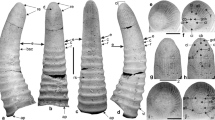Abstract
B. truncata larvae are nearly round in appearance with a dark band around the margin of the shell. The shell is faintly pink near the umbo and at the ventral margin of large larvae. Two interlocking hinge teeth are present in each valve of larvae 70 μ in length or larger. One tooth is about 25 μ long while the other three are 5–10 μ. Straight hinge larvae measure 55–95 μ in length with a straight hinge line about 45 μ long. Height is 0–10 μ less than length, and thickness 20–25 μ less. The umbo is a rounded knob giving larvae a circular appearance and is present in larvae from 85–315 μ in length. In umbo larvae, height is 0–20 μ less than length, and thickness 25 to 80 μ less. Gills are formed before the loss of the velum, and metamorphosis occurs when larvae reach a length of 250–315 μ.
Similar content being viewed by others
Literature Cited
Abbott, R. T. 1954. American seashells.Van Nostrand, Princeton, N.J. 541 p.
Davis, H. C. andR. R. Guillard. 1958. Relative value of ten genera of microorganisms as foods for oyster and clam larvae.U. S. Fish & Wildl. Serv. Fish. Bull. 58 (136):293–304.
Jørgensen, C. B. 1946. Reproduction and development of Danish marine bottom invertebrates. Lamellibranchs.Medd. Kromm. Danmarks Fisk Havundersøg. Ser: Plankton 4(1):277–311.
Kandler, R. 1926. Muschellarven aus dem Helgolander plankton.Wiss. Meeresuntersuch.Bd. V.1 (5)Abt. Helgoland: 1–8.
Lebour, M. V. 1938. Notes on the breeding of some lamellibranchs from Plymouth and their larvae.J. Mar. Biol. Ass. U. K. 23:119–145.
Loosanoff, V. L. 1961. Partial metamorphosis inAnomia simplex.Science 133(3470):2070–2071.
— andH. C. Davis. 1963. Rearing of bivalve mollusks.Adv. Mar. Biol. 1:1–136.
— andJ. B. Engle. 1942. Use of complete fertilizers in cultivation of microorganisms.Science 95 (2471):487–488.
Miyazaki, I. 1936. On the development of some marine bivalves, with special reference to the shelled larvae.J. Imp. Fish. Inst. 31 (2):1–10.
Perry, L. M. 1940. Marine shells of south west Florida.Bull. Am. Paleontol. 29 (95):260.
Quayle, D. V. 1953. The larva ofBankia setacea Tryon.Report, British Columbia Dept. Fish. 51:88–91.
Rees, C. R. 1950. The identification and classification of lamellibranch larvae.Hull Bull. Mar. Ecol. 3:73–104.
Sigerfoos, C. P. 1895. The Pholadidae. Note on the early stages of development.Johns Hopkins Univ. Cir. 14.
Sullivan, C. M. 1948. Bivalve larvae of Malpeque Bay,P.E.I. Bull. Fish. Res. Bd. Canada 77, 36 p.
Werner, B. 1939. Uber die Entwicklung und Artunterscheidung von Muschellarven des Nordseeplanktons, unter besonderer Berücksichtigung der Schalenentwicklung.Zool. Jahr. Abt. Anat. 66 (1):1–54.
Author information
Authors and Affiliations
Additional information
Contribution No. 190 from Virginia Institute of Marine Science.
Rights and permissions
About this article
Cite this article
Chanley, P.E. Larval development of a boring clam,Barnea truncata . Chesapeake Science 6, 162–166 (1965). https://doi.org/10.2307/1350848
Issue Date:
DOI: https://doi.org/10.2307/1350848




